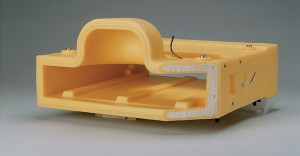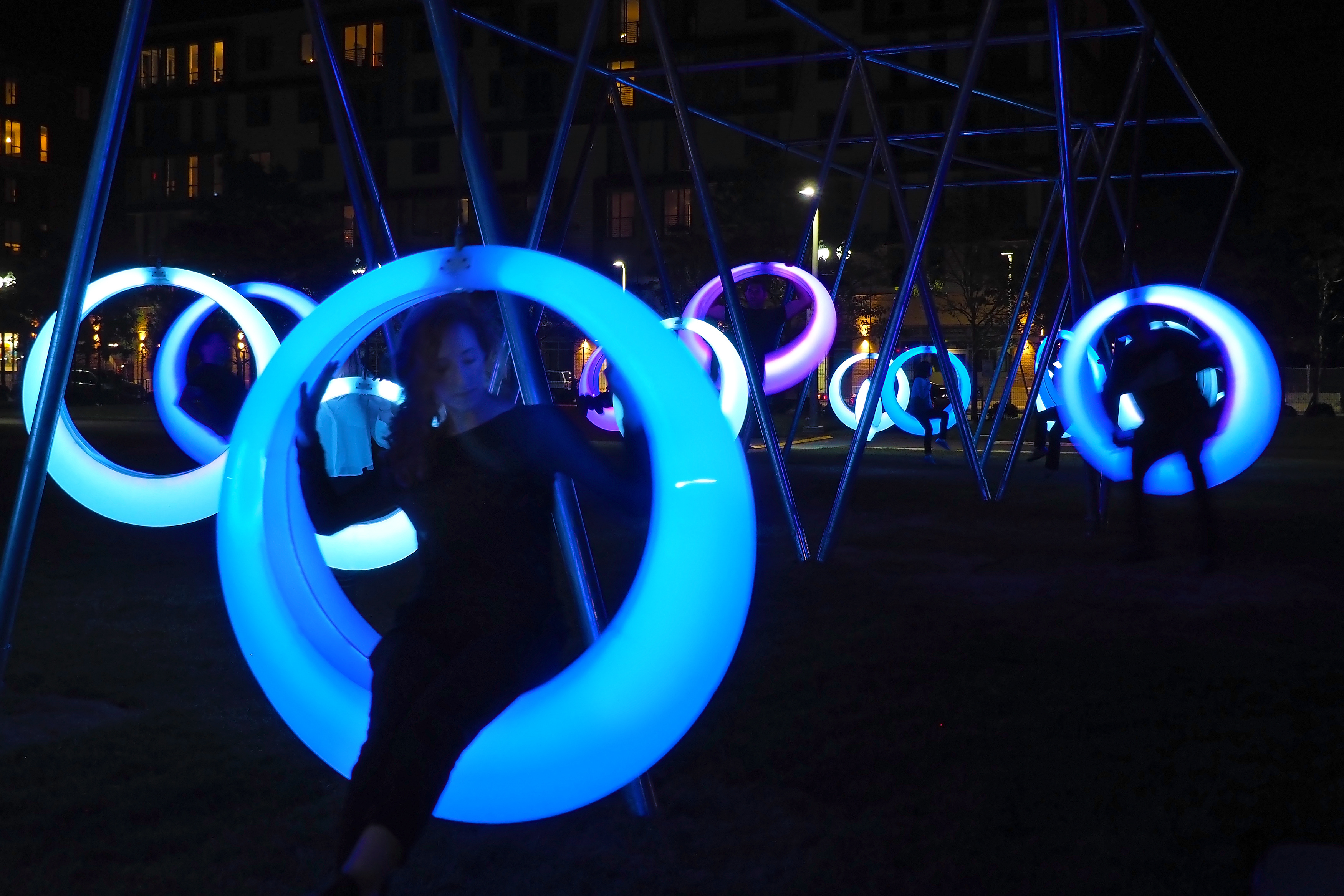Rotational molding produces plastic parts in a wide variety of shapes, sizes, colors, and textures. This manufacturing method also supports undercuts, multiple walls, and molded-in hardware and graphics.
Rotational molding creates hollow plastic parts with low tooling costs and quick tooling modifications. At Gregstrom, this manufacturing method also supports value-added post-mold services like filling plastic parts with polyurethane foam.
How Rotational Molding Works
With rotational molding, powder or resin is loaded into a hollow mold which then rotates on two axes inside an oven until the inside of the mold is coated uniformly. After the mold is cooled, the hollow plastic part is removed. Tooling for rotomolding or rotocasting, as this manufacturing process is also know, ranges from simple two-piece sheet metal molds to multi-piece aluminum molds with articulating features. To learn more, watch this YouTube video.
Rotational Molding Advantages
Rotational molding is ideal for prototyping and for production runs. It’s flexible enough for projects ranging from small, intricate designs to large, complex parts and assemblies. Many rotomolded shapes are impossible to produce by other methods. Plus, because there’s no pressure in this plastics manufacturing process, hardware can be molded-in for strength and durability. Other plastics molding processes can’t support molded-in hardware like rotomolding can.
Additional advantages include:
- Support for a wide variety of surface textures and colors
- Support for uniform walls without the thinning in the extremities that’s common to other processes.
- Rotationally molded parts can also be filled with polyurethane foam for added strength or insulation.
Custom rotomolded parts from Gregstrom can feature Mold In Graphics, a permanent way to mark, decorate, brand, or label your plastic parts. Traditional stickers and labels don’t adhere well to plastic materials, and some require spray adhesives. Mold In Graphics supports permanent labeling, branding, and marking while also providing better resistance to UV, weather, and chemicals.
Rotational Molding Design
There are three basic requirements for rotational molding design. First, the plastic part must meet the application’s end-use or functional requirements. Second, the design of the part must account for any limitations that are related to materials or processing. Third, the rotomolded part must be cost-effective to produce.
Balancing these requirements is important, but rotational molding design still starts with the basic part shape. As a rule, the ideal design for a rotationally-molded part is any hollow shape where the design elements are blended smoothly. In addition to increasing product strength, the smooth blending of part contours supports more efficient and cost-effective production.
Different rotational molding materials have different properties and processing requirements. For example, polycarbonate exhibits low mold shrinkage and hard flow. By contrast, crystalline polyethylene exhibits high mold shrinkage and easy flow. Typically, plastic materials with the smallest mold-shrinkage factors produce the most dimensionally-stable parts.
Because rotational molding is a low-pressure process, the two halves of the mold do not require high-pressure clamping. Compared to injection molding then, rotomolded parts require larger tolerances on part dimensions that are perpendicular to the mold’s parting line. Mold design and construction can affect part quality, and the use of mold release agents can affect part size.
For design engineers, the details of a part’s design can mean the difference between success and failure. Typically, these details include:
- Nominal wall thickness
- Wall thickness uniformity
- Varying wall thickness
- Flatness considerations
- Minimum wall separation
- Corner angle limits
- Reinforcing ribs
- Kiss off ribbing
- Draft angles
- Corner Radiuses
- Undercuts
- Tolerances
Rotational Molding Materials
Part design is important, but so is material selection. Different types of rotomolding materials are available, but there several in particular that designers and engineers should know about.
Linear low-density polyethylene (LLDPE) is durable, provides high tensile strength, and offer good impact and puncture resistance. Applications include plastic tanks, buckets, bins, toys, containers, and outdoor recreational products and equipment. LLDPE rotational molding supports flexible designs, custom colors, and color matching.
High density polyethylene (HDPE) is strong, lightweight, and relatively inexpensive. With its high tensile strength, this rotomolding material can support complex designs and large products. HDPE rotational molding can also support products, such as those used in the food processing industries, which must meet FDA or USDA guidelines.
Polypropylene (PP) is a durable plastic with a high melting point that can also withstand cold-temperature applications. PP is resistant to stress, even when flexed. Moreover, this versatile plastic material won’t react with water, detergents, acids, or bases. Compared to LLDPE, polypropylene is slightly more prone to cracking.
Static-dissipative polyethylene (PE) is recommended for some electrical and electronic applications because it won’t generate a potentially hazardous electrical charge. Often, static-dissipative PE is used with highly-sensitive electronics and can comply with industry standards. Unlike anti-static materials, static-dissipative materials both reduce the risk of a charge and protect against existing charges.
Rotational Molding Applications
Gregstrom can create many different types of custom rotomolded parts. Examples from our roto molding services portfolio include:
- Plastic Ventilation Ducts
- Chemical Feeder Assemblies
- Plastic Shopping Cart Parts
- Plastic Manifolds
- Plastic Bins and Pallets
- Plastic Mufflers
- POP Assemblies
- Boats
- Spine Boards
- Baby Changing Stations
- Lawn/Garden Equipment Housings
- Printer Housings
- Plastic Tanks
Rotational Molding Equipment
 Gregstrom uses Ferry Rotospeed RS-220 and RS2-3300 machines to manufacture your custom rotomolded parts. Each machine has offset arms, and the largest machine has up to 125” swing. This means we can rotomold plastic parts in a wide ranges of sizes and shapes from intricate spray manifolds to small boats.
Gregstrom uses Ferry Rotospeed RS-220 and RS2-3300 machines to manufacture your custom rotomolded parts. Each machine has offset arms, and the largest machine has up to 125” swing. This means we can rotomold plastic parts in a wide ranges of sizes and shapes from intricate spray manifolds to small boats.
High-Intensity Mixing
Gregstrom’s auxiliary equipment for rotomolding includes a Ribbon/Paddle Blender with a 1000-lb. capacity. Our newest machine, a high-intensity mixer with a capacity of 300 lbs., provides even faster mixing cycles and features an optimized vortex for heat generation and shear to avoid agglomeration of the mix material. This new machine “polishes” the resin, which means more uniform colors, reduced porosity and improved overall physical properties.
Polyurethane Foam Filling
 Gregstrom also has the equipment and expertise to fill your custom rotomolded parts with polyurethane foam, which provides additional rigidity and thermal insulation. Because rotomolded parts (such as coolers) have hollow cavities, their design is optimal for filling with PU foam.
Gregstrom also has the equipment and expertise to fill your custom rotomolded parts with polyurethane foam, which provides additional rigidity and thermal insulation. Because rotomolded parts (such as coolers) have hollow cavities, their design is optimal for filling with PU foam.
Rotational Molding That’s Made in the USA
For nearly 70 years, Gregstrom Corporation has been forming and molding plastics at our Made in the USA manufacturing facilities in Massachusetts. To learn how our roto molding services can support your application, contact us online or call (781) 935-6600.
